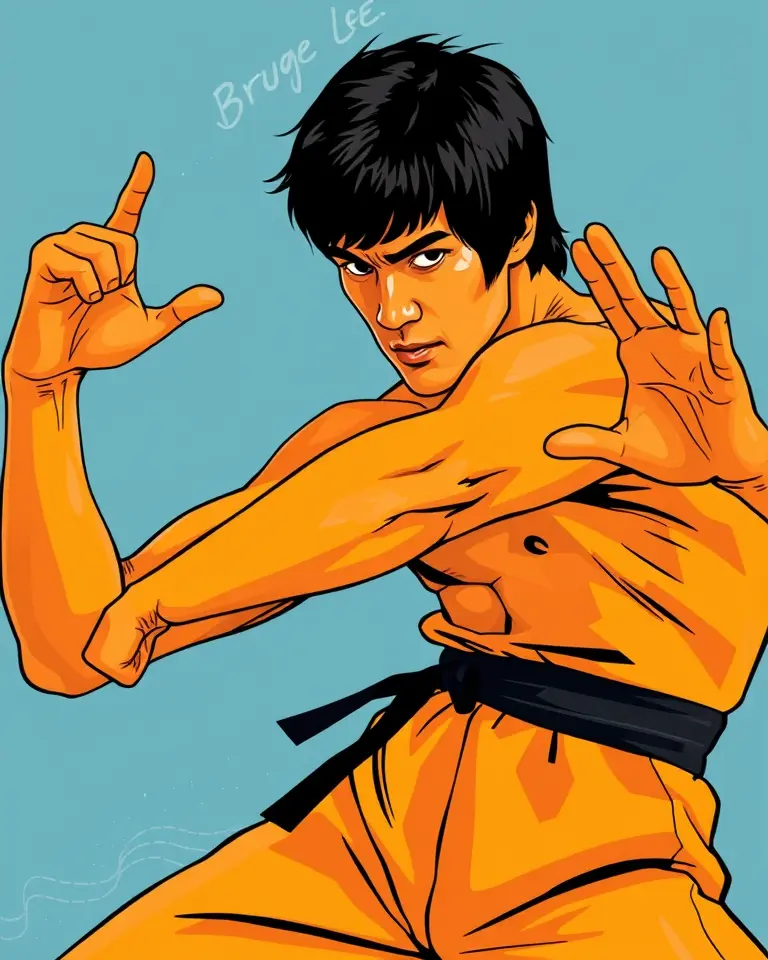Bruce Lee, the legendary martial artist, actor, and philosopher, remains an icon of physical prowess and dedication. While his explosive movements and sculpted physique are well-known, the specifics of his training regimen, particularly in his early years, are often a subject of fascination. A recently resurfaced gym card from 1965 offers a glimpse into his workout routine during that pivotal time. This article delves into Bruce Lee’s 1965 training program, exploring the exercises, his overall approach to fitness, and what we can learn from his methods.
The Hak Keung Gymnasium Routine
In 1965, Bruce Lee was actively establishing himself in the martial arts world while also beginning his foray into acting. He was teaching and competing, and had gained some attention for his role in the TV series “The Green Hornet”. During this period, he frequented the Hak Keung Gymnasium in Hong Kong, where he diligently documented his workouts. The gym card, dated May 27, 1965, provides a detailed snapshot of his training session, revealing a mix of strength and conditioning exercises.
Strength Training Exercises
Lee’s 1965 workout included the following exercises:
- Squats: 3 sets of 10 repetitions with 95 pounds (approximately 43 kilograms). This exercise is a compound movement, working multiple muscle groups in the legs, and crucial for overall lower body strength.
- French Press (Lying Triceps Extensions): 4 sets of 6 repetitions with 64 pounds (approximately 29 kilograms). This exercise targets the triceps, the muscles at the back of the upper arm, and was likely performed using a barbell.
- Incline Curls: 4 sets of 6 repetitions with 35 pounds (approximately 16 kilograms). Incline curls emphasize the long head of the biceps and promotes a greater range of motion compared to standard curls.
- French Press (Second set): 4 sets of 6 repetitions with 64 pounds (approximately 29 kilograms). This second set demonstrates a focus on triceps development.
- “Con” Curls (Concentration Curls): 3 sets of 10 repetitions with 70-80 pounds (approximately 32-36 kilograms). Concentration curls help isolate the biceps muscle, further enhancing arm strength.
- Two-Handed Curls: 3 sets of 8 repetitions with 70-80 pounds (approximately 32-36 kilograms). This was another exercise to build bicep strength.
- Tricep Stretch: 3 sets of 8 repetitions. This likely refers to an exercise that stretches or strengthens the triceps muscles
- Dumbbell Curls: 4 sets to failure with 18 pounds (approximately 8 kilograms). This exercise involves curling the dumbbells until exhaustion, focusing on muscle endurance.
- Reverse Curls: 4 sets of 6 repetitions with 64 pounds (approximately 29 kilograms). Reverse curls work the forearms and biceps.
- Wrist Curls: 4 sets to failure with 64 pounds (approximately 29 kilograms). Wrist curls are performed to improve forearm strength and wrist flexibility.
- Wrist Curls (second set): 4 sets to failure with 10 pounds (approximately 4.5 kilograms). A lighter weight for more reps to achieve failure.
This routine showcases Lee’s focus on building upper body strength, particularly in his arms and forearms, which are essential for martial arts techniques like punches and blocks. It also highlights his attention to building a well-rounded physique through a combination of compound and isolation exercises.
Additional Exercises
Beyond the exercises recorded on the gym card, other sources reveal that Bruce Lee also incorporated:
- Push-ups: He included variations of push-ups in his workouts, sometimes even using weights to increase the intensity.
- Sit-ups: Bruce Lee would perform several sets of sit-ups, sometimes with added weight, to enhance core strength.
- Calf Raises: He completed 5 sets of 20 repetitions of calf raises to improve lower leg strength.
The Evolution of Bruce Lee’s Training
While the 1965 workout provides a starting point, Bruce Lee’s training methods were constantly evolving. His early workouts focused on a “bro split,” emphasizing different muscle groups on different days, but he moved towards more functional routines that supported his martial arts practice.
Later Weight Training Routines
As Lee’s training philosophy matured, he shifted towards compound movements done at lower volumes with more focus on explosiveness and speed. He eventually settled on a weight training program that looked something like this:
- Clean and press: 2 sets of 8 reps
- Squats: 2 sets of 12 reps
- Barbell Pullover: 2 sets of 8 reps
- Bench Press: 2 sets of 6 reps
- Good mornings: 2 sets of 8 reps
- Barbell Curl: 2 sets of 8 reps
This later routine focused on full-body strength and power, essential for martial arts. Lee also incorporated Olympic lifts like the clean and press, and prioritized movements that directly translated to improved fighting ability.
Calisthenics
Bodyweight exercises were a fundamental part of Lee’s training. He believed in functional strength and used calisthenics to develop a body that was strong, agile, and capable of explosive movements. His famous two-finger push-ups and one-arm pull-ups are testaments to his dedication to bodyweight training.
Core Training
Bruce Lee was known for his incredibly strong core, which he trained daily. His core workouts included a variety of exercises:
- Sit-ups: 4 sets of 20
- Side bends: 4 sets of 15-20
- Leg raises: 4 sets of 20
- Twists: 4 sets of 50
- Frog kicks: 4 sets of 20.
He understood that a powerful core is crucial for generating power in punches and kicks, and for overall stability and balance. Lee also used other exercises like dragon flags, hanging leg raises, weighted side bends, and leaning twists to target all aspects of core strength. He also believed in the importance of diet for achieving a low body fat percentage that would accentuate his abdominal muscles.
Cardio
Cardiovascular training was another cornerstone of Lee’s fitness program. He ran 2-6 miles on Mondays, Wednesdays, and Fridays. On Tuesdays, Thursdays, and Saturdays, he would cycle about 10 miles followed by 20 minutes of jump rope. He often incorporated the “heavy hands” method by holding light dumbbells or wearing ankle weights while running. Lee sometimes used a “fartlek” approach to running, alternating between paces, similar to modern HIIT training. He believed that running was an effective way to improve stamina and endurance.
The Martial Arts Element
It’s essential to remember that Bruce Lee’s physical training was always in service of his martial arts practice. He trained in a variety of disciplines including:
- Wing Chun: Lee’s early training began with Wing Chun under the tutelage of Ip Man, which laid the foundation for his martial arts journey.
- Boxing: Bruce Lee was also an accomplished boxer, even winning a tournament in Hong Kong
- Judo Lee also incorporated elements of Judo.
- Other Martial Arts: Lee also studied Taekwondo, Karate and Escrima.
He would alternate his training days between working on combative leg moves, and arm and hand techniques. Lee would perform 500 punches per day, sometimes holding light weights to focus on speed and endurance. He used heavy bags to develop power and frequently shadowboxed to hone his agility and speed.
Jeet Kune Do
Lee’s experiences and studies led him to develop his own martial art, Jeet Kune Do, which translates to “The Way of the Intercepting Fist”. It was a hybrid martial arts philosophy emphasizing adaptability, fluidity, and efficiency, drawing from various fighting styles. Lee believed in the “style of no style,” meaning one should not be confined to one specific martial art, but rather adapt and use what is most effective for a given situation.
Bruce Lee’s Diet
Nutrition was another critical component of Bruce Lee’s training regimen. He favored Asian cuisine and focused on a balanced intake of protein, carbohydrates, and healthy fats.
- Protein: His diet was rich in lean protein sources such as beef, chicken, shrimp, tofu, and organ meats.
- Carbohydrates: Lee did not shy away from carbohydrates, particularly those found in vegetables and fruits.
- Fats: Healthy fats were also included in his diet.
He avoided processed foods, sweets, and refined carbs. He emphasized whole, nutritious foods and made his own juices with a mix of fruits and vegetables. Lee also supplemented his diet with vitamins such as C, E, and B, as well as bee pollen and lecithin granules.
Lessons From Bruce Lee’s Approach
Bruce Lee’s training philosophy was based on several principles:
- Functional Fitness: He focused on exercises that enhanced his martial arts abilities rather than just aesthetics.
- Holistic Approach: Lee understood the importance of integrating strength, flexibility, cardio, martial arts, and nutrition.
- Adaptability: He constantly experimented and adapted his training methods to optimize his performance.
- Quality over Quantity: Lee believed in focusing on the quality of each repetition, rather than just doing high-volume reps.
- Mental Fortitude: Lee blended rigorous physical training with mindfulness and meditation, understanding the importance of mental strength in martial arts and overall well-being.
Conclusion
Bruce Lee’s 1965 workout routine, while seemingly basic by today’s standards, is a testament to his dedication and innovative approach to fitness. It reveals his early focus on building a strong foundation of strength and conditioning while constantly evolving his methods to better serve his martial arts goals. His training regimen combined weightlifting, calisthenics, core work, cardio, and martial arts practice, and was fueled by a balanced, nutritious diet. By studying his methods, aspiring martial artists, and fitness enthusiasts can gain valuable insights into how to achieve peak physical condition and reach their full potential.







